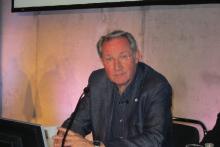BERLIN – The harm-reduction concept as an alternative to abstinence as a treatment strategy for alcohol dependence has taken on new legitimacy as a result of the recent approval of nalmefene by the European Medicines Agency.
Nalmefene, an opioid receptor antagonist, received marketing approval across Europe for use specifically in a novel as-needed dosing regimen that is under the patient’s control. One 18-mg tablet is to be taken on days when a patient anticipates a risk of drinking, or if the patient has already started drinking, then as soon as possible.
The indication was granted by European regulators on the strength of three European phase III randomized trials that showed that heavy drinkers who used nalmefene in this way reduced their alcohol consumption to a more normal level. Thus, marketing approval was an implicit endorsement of the harm-reduction strategy.
“I have been praying for this for years and years. I have been strictly against the concept of complete abstinence, because the core of the disease of addiction is relapse. It is just a natural thing that one relapses,” Rainer Spanagel, Ph.D., said at the annual congress of the European College of Neuropsychopharmacology.
“It has been a major mistake to say you are only successful in the field of addiction treatment if there is abstinence. This is an almost unreachable goal. This goal, set out to achieve for decades now, has been almost impossible for most patients to achieve,” added Dr. Spanagel, director of the Institute of Psychopharmacology at the University of Heidelberg (Germany).
Dr. Robert M. Swift noted that most treatment programs in the United States still promote abstinence as the only acceptable treatment outcome. It’s a concept that dates back to the 1800s and was heavily promoted by Alcoholics Anonymous beginning in the early 1900s, a period before there was any viable treatment for alcoholism.
Today, a variety of treatments have proved effective, both psychosocial as well as pharmacologic, but people aren’t receiving them. A large epidemiologic study conducted by the National Institute on Alcohol Abuse and Alcoholism estimated that of 7.9 million Americans who are alcohol dependent, only 2.4 million have ever been diagnosed as such, 1.5 million have ever gotten any treatment for their disorder, and a mere 139,000 have ever received pharmacotherapy.
“There’s this amazing treatment gap,” commented Dr. Swift, professor of psychiatry and associate director of the Center for Alcohol and Addiction Studies at Brown University in Providence, R.I.
The main reason for this huge treatment gap was revealed in a 2012 survey conducted by the U.S. Substance Abuse and Mental Health Services Administration: 49.5% of participants who had not sought treatment for an alcohol problem within the past year even though they needed it and recognized their need for it gave as their reason that they were just not ready to stop drinking completely. This is a group where the harm-reduction strategy makes a great deal of sense, the psychiatrist said.
Harm reduction is based upon evidence that the risk of mortality because of alcohol-related causes rises exponentially as daily consumption climbs above the threshold of hazardous drinking, which has been defined by U.S. public health officials as five drinks per day or 15 per week in men and four per day or eight per week in women. The corollary is that reducing heavy drinking provides exponential health benefits. Investigators at Imperial College, London, have estimated that reducing alcohol intake from 100 g per day to 50 g per day provides an eight-fold reduction in health harms (J. Psychopharmacol. 2014;28:3-7).
“You get a lot of bang for your buck by reducing the amount of alcohol you consume,” Dr. Swift said. “The evidence really is out there that reducing drinking is an effective harm reduction strategy.”
Dr. Wim van den Brink, who led the SENSE trial, a 1-year, phase III, randomized, placebo-controlled study with positive safety and efficacy outcomes for nalmefene as-needed (J. Psychopharmacol. 2014;28:733-44), said one of the strengths of this treatment strategy is that it gives patients responsibility for their drinking and allows them to set their own treatment goals. That enhances the likelihood of successful outcomes.
The harm-reduction approach with as-needed nalmefene also is a way to bring into treatment some of the 50% of problem drinkers who don’t want to stop drinking entirely, added Dr. van den Brink, professor of psychiatry and addiction at the University of Amsterdam and director of the Amsterdam Institute for Addiction Research.
A spokesperson for Lundbeck, which sponsored the SENSE and 6-month ESENSE 1 and ESENSE 2 trials, said the company would not seek marketing approval for nalmefene in the United States because the drug’s remaining duration of patent protection makes it commercially nonviable.



